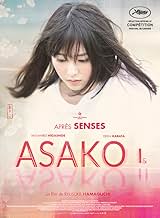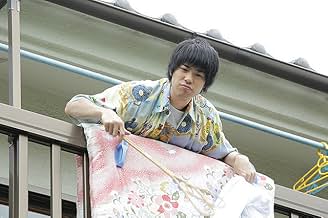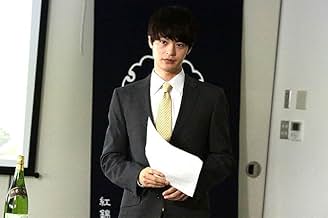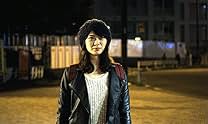IMDb-BEWERTUNG
7,1/10
5868
IHRE BEWERTUNG
Asako lebt in Osaka. Sie verliebt sich in Baku. Eines Tages verschwindet er. Zwei Jahre später lebt Asako nun in Tokio und lernt Ryohei kennen. Er sieht genauso aus wie Baku, hat aber eine g... Alles lesenAsako lebt in Osaka. Sie verliebt sich in Baku. Eines Tages verschwindet er. Zwei Jahre später lebt Asako nun in Tokio und lernt Ryohei kennen. Er sieht genauso aus wie Baku, hat aber eine ganz andere Persönlichkeit.Asako lebt in Osaka. Sie verliebt sich in Baku. Eines Tages verschwindet er. Zwei Jahre später lebt Asako nun in Tokio und lernt Ryohei kennen. Er sieht genauso aus wie Baku, hat aber eine ganz andere Persönlichkeit.
- Regie
- Drehbuch
- Hauptbesetzung
- Auszeichnungen
- 3 Gewinne & 10 Nominierungen insgesamt
Empfohlene Bewertungen
Emergent Japanese filmmaker Ryûsuke Hamaguchi, after his international breakthrough HAPPY HOUR (2015), is welcomed to Cannes' main competition for its follow up ASAKO I & II, an adaptation of Tomoka Shibasaki's 2010 novel.
The story traces a threadbare template of a young woman Asako's (newcomer Karata in her first film) internal struggle between two men Bako and Ryohei (both played by Higashide), who look just like each other but equipped with polarized personalities. After a prologue setting in Osaka, delineates the evanescent passion between Asako and Bako, the meat of the story relocates Asako to Tokyo, two years after Bako vanishes from her life apropos of nothing, she works in a coffee shop and bumps into Ryohei, a sake company salaryman with an uncanny resemblance of Bako, only, Ryohei turns out to be a gregarious, straight-arrow type that is nothing similar to Bako's enigmatic, ethereal insouciance.
Initially shocked to her core, Asako is gradually won over by many virtues Ryohei exhibits and after a tentative consent of his courtship, their wavering commitment is significantly cemented by the Great East Japan Earthquake in 2011, 6 years later, the present day, they are still together and Asako truly grows into a deeper affection to Ryohei, but a reunion with Hayuro (Itô), her best friend in Osaka, augurs the ineluctable re-entry of Bako, now a celebrated heartthrob, into her life, just after she comes clean her relationship with Bako to Ryohei (who confesses that he has divined a thing or two in the past years) and gallantly waves adieu to that seemingly closed chapter in the life, when the crunch comes, her impulsive reaction betrays the complexity of her id, after a dreamlike nocturnal driving on the highway with her knight in shining armor, she comes to a sudden awakening, and has a daunting job to win over Ryohei's heart again, or maybe not, Hamaguchi imbues a realistic spin in their final shot, both looking right into the camera to their indeterminate future.
Conceptually and thematically evoking Ozon's DOUBLE LOVER (2017), plus as its English title reveals, ASAKO I & II, Hamaguchi's conceit actually zooms in on Asako's dual oscillation (the idealized versus the realistic version of her affection) rather than on his literally doubled male protagonists, but through Karata's passive gaze, quiet performance and greenness, that oscillation is all to well buried underneath whereas Higashide lights up the screen with his compassionate incarnation of an ultimate good guy unfairly taking the short end of the stick in their lopsided relationship, thus the twofold revelations come off as a shade over-dramatic albeit Hamaguchi proves to be a superlative raconteur, it is not an easy job to weave a banal love triangle into an organic entity of compelling watching, and somehow, he manages that with great distinction, especially by conducting a tooth-comb of the narrative arc through supporting characters.
Apart from his gazing-at-the-lens MO (Asako, first meets Bako, then with Royhei in two Shigeo Gocho's SELF AND OTHERS exhibitions, tacitly carries off the parallels), Hamaguchi also struts his stuff with an aptitude with lights and scenic composition, betokened by the gradation of sunlight shadowing the rain-dappled field in the aerial shot near the end. All in all, ASAKO I & II is an auspicious discovery of a new Japanese auteur in the vein of Hirokazu Koreeda and Naomi Kawase, that is something every cineaste should extol!
The story traces a threadbare template of a young woman Asako's (newcomer Karata in her first film) internal struggle between two men Bako and Ryohei (both played by Higashide), who look just like each other but equipped with polarized personalities. After a prologue setting in Osaka, delineates the evanescent passion between Asako and Bako, the meat of the story relocates Asako to Tokyo, two years after Bako vanishes from her life apropos of nothing, she works in a coffee shop and bumps into Ryohei, a sake company salaryman with an uncanny resemblance of Bako, only, Ryohei turns out to be a gregarious, straight-arrow type that is nothing similar to Bako's enigmatic, ethereal insouciance.
Initially shocked to her core, Asako is gradually won over by many virtues Ryohei exhibits and after a tentative consent of his courtship, their wavering commitment is significantly cemented by the Great East Japan Earthquake in 2011, 6 years later, the present day, they are still together and Asako truly grows into a deeper affection to Ryohei, but a reunion with Hayuro (Itô), her best friend in Osaka, augurs the ineluctable re-entry of Bako, now a celebrated heartthrob, into her life, just after she comes clean her relationship with Bako to Ryohei (who confesses that he has divined a thing or two in the past years) and gallantly waves adieu to that seemingly closed chapter in the life, when the crunch comes, her impulsive reaction betrays the complexity of her id, after a dreamlike nocturnal driving on the highway with her knight in shining armor, she comes to a sudden awakening, and has a daunting job to win over Ryohei's heart again, or maybe not, Hamaguchi imbues a realistic spin in their final shot, both looking right into the camera to their indeterminate future.
Conceptually and thematically evoking Ozon's DOUBLE LOVER (2017), plus as its English title reveals, ASAKO I & II, Hamaguchi's conceit actually zooms in on Asako's dual oscillation (the idealized versus the realistic version of her affection) rather than on his literally doubled male protagonists, but through Karata's passive gaze, quiet performance and greenness, that oscillation is all to well buried underneath whereas Higashide lights up the screen with his compassionate incarnation of an ultimate good guy unfairly taking the short end of the stick in their lopsided relationship, thus the twofold revelations come off as a shade over-dramatic albeit Hamaguchi proves to be a superlative raconteur, it is not an easy job to weave a banal love triangle into an organic entity of compelling watching, and somehow, he manages that with great distinction, especially by conducting a tooth-comb of the narrative arc through supporting characters.
Apart from his gazing-at-the-lens MO (Asako, first meets Bako, then with Royhei in two Shigeo Gocho's SELF AND OTHERS exhibitions, tacitly carries off the parallels), Hamaguchi also struts his stuff with an aptitude with lights and scenic composition, betokened by the gradation of sunlight shadowing the rain-dappled field in the aerial shot near the end. All in all, ASAKO I & II is an auspicious discovery of a new Japanese auteur in the vein of Hirokazu Koreeda and Naomi Kawase, that is something every cineaste should extol!
The story certaintly has an interesting premise in concept, but the execution is shallow. Theres nothing to this movie, read the description and you've pretty much got the movie, her first boyfriend disappears, she gets together with "Asako" 2-----thats it. Actually watching the movie will not take you much further than that. Its also painfully cringe with the dumb/childish women trope.
Nothing is ever explained, people in the movie just act weird for no reason, leading to "dramatic" moments.
'Undine' 2020 has similarities with the 1 girl/ 2 guys and is better than this, if you're going to give something a go, watch that instead.
Nothing is ever explained, people in the movie just act weird for no reason, leading to "dramatic" moments.
'Undine' 2020 has similarities with the 1 girl/ 2 guys and is better than this, if you're going to give something a go, watch that instead.
Part of my accidental trilogy of "love" films in Oct 2022, this film shares some aspects with "Marriage is a Crazy Thing." That aspect of a "grass is greener" approach to romance; the power of the flirt/affair/infatuation vs a day-to-day reliable relationship.
Recently I've also been making my way through director Hamaguchi-san's catalog. I enjoy his lingering on scenes, one man battling against the ADD urging of our consumer society. He often leaves the camera fixed absent of characters, inviting introspection. He also likes the ironic juxtaposition of a character in some mode of transportation, but not really moving personally.
Anyways, I did not find this movie slow at all and disagree with those who did.
Perhaps an ongoing observation from Hamaguchi, or maybe on Japan, is the role of the small community in individual lives. I'm thinking in particular of the friends of Asako and Ryohei, and how their relationship is woven into and seen through that larger circle. Some deeply personal moments happen in public settings, contrast this with the Korean covert relationship in "Marriage is a Crazy Thing" or the USA "Meet Cute" where the community surrounding our eternal lovers is comprised almost entirely of service workers: bartender, nail salon worker and a maitre d.
In the US, others are inherently extras? Hmmmm....
Anyways, if Asako is Cinderella here, it is almost surprising that she has to choose between comfy sneakers and stylish but not so functional glass slippers. There is a sort of urban fairy tale concocted via a doppelganger (meanwhile Hamaguchi saves on acting costs with a 2-for-1 deal on leading men;>).
Ultimately the film is a gentle study in trying to grow up, but especially when balanced against that power of the first love/flirtation/etc. I know the title of the film alludes to the two faces of Asako, but the title of my review refers to what happens to Ryohei after the credits roll. I find that interesting to think about and appreciate those who forgive even if forgetting is not an option.
Another askew interpretation (my favorite kind!) for the film might be the importance of raising a kitten. I was curious to look up the name of their pet cat and found
"The name Jintan combines the Confucian term jin ( humaneness, benevolence), with the Daoist term tan (cinnabar, pills containing cinnabar, pills (the Elixir of life)) evoking the notion of longevity and health."
Recently I've also been making my way through director Hamaguchi-san's catalog. I enjoy his lingering on scenes, one man battling against the ADD urging of our consumer society. He often leaves the camera fixed absent of characters, inviting introspection. He also likes the ironic juxtaposition of a character in some mode of transportation, but not really moving personally.
Anyways, I did not find this movie slow at all and disagree with those who did.
Perhaps an ongoing observation from Hamaguchi, or maybe on Japan, is the role of the small community in individual lives. I'm thinking in particular of the friends of Asako and Ryohei, and how their relationship is woven into and seen through that larger circle. Some deeply personal moments happen in public settings, contrast this with the Korean covert relationship in "Marriage is a Crazy Thing" or the USA "Meet Cute" where the community surrounding our eternal lovers is comprised almost entirely of service workers: bartender, nail salon worker and a maitre d.
In the US, others are inherently extras? Hmmmm....
Anyways, if Asako is Cinderella here, it is almost surprising that she has to choose between comfy sneakers and stylish but not so functional glass slippers. There is a sort of urban fairy tale concocted via a doppelganger (meanwhile Hamaguchi saves on acting costs with a 2-for-1 deal on leading men;>).
Ultimately the film is a gentle study in trying to grow up, but especially when balanced against that power of the first love/flirtation/etc. I know the title of the film alludes to the two faces of Asako, but the title of my review refers to what happens to Ryohei after the credits roll. I find that interesting to think about and appreciate those who forgive even if forgetting is not an option.
Another askew interpretation (my favorite kind!) for the film might be the importance of raising a kitten. I was curious to look up the name of their pet cat and found
"The name Jintan combines the Confucian term jin ( humaneness, benevolence), with the Daoist term tan (cinnabar, pills containing cinnabar, pills (the Elixir of life)) evoking the notion of longevity and health."
The main character doesn't seem like a real person. Towards the end of the movie, her actions are wrenching for everyone. Unfortunately, there doesn't seem to any particular reason for them.
Other than this, the movie can be boring. There's no reason it could not have been 90 minutes instead of two hours.
Earlier in the movie there was an awkward scene at a party that I could have done without.
I've seen hundreds of Japanese movies. Too often they are depressing and/or harrowing. Lately, opaque characters who are randomly destructive are cropping up.
WARNING: If you do see this movie at a theater, it looks like it might have no previews and starts right on time.
Other than this, the movie can be boring. There's no reason it could not have been 90 minutes instead of two hours.
Earlier in the movie there was an awkward scene at a party that I could have done without.
I've seen hundreds of Japanese movies. Too often they are depressing and/or harrowing. Lately, opaque characters who are randomly destructive are cropping up.
WARNING: If you do see this movie at a theater, it looks like it might have no previews and starts right on time.
Interesting premise, but flat characters making infuriating decisions made this one tough to fully appreciate. It's a film that had its moments in the interplay between the friends, but felt too simplistic at the core of its love triangle, and dragged on too long. I liked the idea of exploring the compromises usually necessary in a stable relationship vs. The wild ride our hearts might lead us on, but this didn't feel much like an exploration, perhaps because the central character (Erika Karata) is so weakly drawn.
Maybe if you've been left in the past by a partner you truly loved, someone who if they showed up out of the blue might cause you to throw everything that's good in your life away, it may resonate more for you, but for me I couldn't buy it. Solid performance from Masahiro Higashide in the dual role, and I liked the character of Maya (Rio Yamashita) here - if only her fate had been a little more intertwined with that of Ryohei's.
Maybe if you've been left in the past by a partner you truly loved, someone who if they showed up out of the blue might cause you to throw everything that's good in your life away, it may resonate more for you, but for me I couldn't buy it. Solid performance from Masahiro Higashide in the dual role, and I liked the character of Maya (Rio Yamashita) here - if only her fate had been a little more intertwined with that of Ryohei's.
Wusstest du schon
- WissenswertesThe first commercially produced film directed by Ryûsuke Hamaguchi.
- VerbindungenFeatured in Fandor: Cannes You Dig It? | Fandor Spotlight (2022)
Top-Auswahl
Melde dich zum Bewerten an und greife auf die Watchlist für personalisierte Empfehlungen zu.
- How long is Asako I & II?Powered by Alexa
Details
- Erscheinungsdatum
- Herkunftsländer
- Offizielle Standorte
- Sprachen
- Auch bekannt als
- Asako I & II
- Drehorte
- Produktionsfirmen
- Weitere beteiligte Unternehmen bei IMDbPro anzeigen
Box Office
- Bruttoertrag in den USA und Kanada
- 25.559 $
- Eröffnungswochenende in den USA und in Kanada
- 5.690 $
- 19. Mai 2019
- Weltweiter Bruttoertrag
- 645.313 $
- Laufzeit
- 1 Std. 59 Min.(119 min)
- Farbe
- Seitenverhältnis
- 1.66 : 1
Zu dieser Seite beitragen
Bearbeitung vorschlagen oder fehlenden Inhalt hinzufügen










